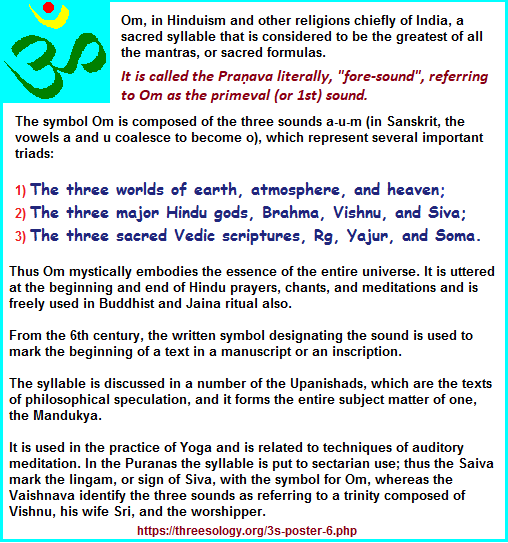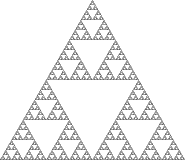Three and Counting ...1
A Study of the Repeating 3s Phenomena
| Home Page | Addendum | Page 2 | Page 3 |
| Page 4 | Page 5 | More Threes Examples | AI 3s and 2s |
3s Enthusiasts as of June 6th, 2025

|
|
Once You Understand OM (3's), You Understand Everything about Reality YouTube Presentation by Adhvaitha (Non-Dual Spirituality)


AUM correlations involves the use of describing and explaining the "OM" chant as a type of cipher, or (not-so-secret anymore) code that is related to other devices of coding and decoding; all of which are techniques/strategies of thinking explored and practiced at different periods of history, and likewise show up in Nature's experimentations of developmental biology, as well in all subjects where interested persons try to unravel some suppose code, pattern, "word of God", "voice of the Universe", Hidden mysteries, etc...
"But when considered as a triliteral word consisting of a, u, m, (~~~), Om implies, the three Vedas, the three states of human nature; the three divisions of the Universe; the three deities, agents of the three states of things—the creation, preservation and destruction; or properly speaking; the three principle attributes of the Supreme Being. In this sense it implies in fact the Universe controlled by the Supreme Being." (Ram Mohun Roy.): Triads or Triples or Tripartite om in Trinitarian systems
Let us initially note (In terms of the 3 letters (2 vowels and 1 consonant)):
- AUM, A-UM, AU-M, (OM)
- MUA, M-UA, MU-A
- OM/ MO
- MOM/ MA (Mother)
Translations of "Mother" in Different Languages:
- Spanish: madre
- French: mère
- German: Mutter
- Italian: madre
- Portuguese: mãe
- Russian: (mat')
- Chinese (Mandarin): (muqin) or (mama) for a more affectionate term
- Japanese: (okaasan) or (haha) for a formal term
- Arabic: (umm)
- Hindi: (ma~)
- Korean: (eomeoni) or (eomma) for a more casual term
- Turkish: anne
- Swahili: mama
- Greek: (mitéra)
- Hebrew: (ima)
In many cultures, the word for "mother" carries deep emotional significance, often associated with love, care, and nurturing. Variations of the term can reflect different levels of formality or affection.
- For example, in Spanish, "madre" is formal, while "mamá" is more affectionate.
- In Chinese, while (muqin) is the formal term, (mama) is commonly used by children.
- MuMu What Mumu Means in Different Parts of the World.
- Initially spoken as "AMUN" then later by infusing the Sun God RA; Amun-Ra (alternatively spelled Amon-Ra or Amun-Re):
- AMEN: Amen[a] is an Abrahamic declaration of affirmation which is first found in the Hebrew Bible, and subsequently found in the New Testament. It is used in Jewish, Christian, and Islamic practices as a concluding word, or as a response to a prayer. Common English translations of the word amen include "verily", "truly", "it is true", and "let it be so".[5][6] It is also used colloquially to express strong agreement.
- Mu): Mu is a lost continent introduced by Augustus Le Plongeon (1825–1908), who identified the "Land of Mu" (Mother Continent/ "Mother Land" of Humanity) with Atlantis. The name was subsequently identified with the hypothetical land of Le-mu-ria by James Churchward (1851–1936), who asserted that it was located in the Pacific Ocean before its destruction. The place of Mu in both pseudoscience and fantasy fiction is discussed in detail in Lost Continents (1954, 1970) by L. Sprague de Camp. Geologists state that the existence of Mu and the lost continent of Atlantis has no factual basis, and is physically impossible, as a continent can neither sink nor be destroyed in the short period of time asserted in the legends, folklore and literature about these places.

H.O.B note: Unfortunately, those examining the idea of MU use a geological perspective of association, just as they do for multiple types of life-associated time lines, and do not approach the idea from a Cognitive/ Psychological or Auditorial/ Linguistic position. Even if the concept of MU is a fantasy, it nonetheless is real in terms of a cognitive orientation developed by the human mind which can be correlated with other fanciful notions such as the Hindu AUM, Western religion's AMEN, and the ancient Egyptian AMON-Ra regardless if one idea has millions of believers and another idea only has a few.
Like Religion claiming a dominant property ownership to the concept of god, evil, and very many ideological considerations, Geology is acted upon like a religion by many who want to assert it has the dominant property rights to a fixed reality of traditionalized proofs. This is just as stupidly arrogant as Mathematics being claimed as the Queen of all sciences and that any rational sentient being in the Universe would use a Human-based mathematics as a starting point of inter-species communication, though the Persistent Use of Dichotomies in Mathematics is an obstacle to understanding a mathematics that would be based on Trichotomization or some other formula of cognitive activity; and presents us with the problematic issue that for those children whose brain is venturing into trichotomization, they are being forced to Kow Tow to a society that is mostly oblivious to such a consideration of developmental growth, and instead labels such students as being "off topic", or out-of-touch with reality, or in need of some chemical restraint in order to supress hyper-acting-out activity, or in need of multiple time outs (social ostracism... like forcing the biblical character Lazarus to live in a cave at the fringes of society, whereby Jesus performed a metaphorical miracle and brought him "back to life" to live among the socially dependent others), or subject a person to some measure of accepted (and expected) religious brainwashing, etc., in order to force them into the prevailing so-called "Normalcy" of a given time and place.
Here are some further examples of the very large landscape of humanity's varied cognitive activity which must be taken into any effort of adopting a cross-cultural and cross-time period accountability of ideas being shared, stolen, borrowed, independently recreated, and of course creative and original illustrations:
- Using juxtapositioning such as Palindroming... sometimes referred to as inversion, mirror-imaging, backwards writing).
- Speaking in Tongues
- Mathematics is a language of codes (Based on a binary system relying on a reference model of required axioms and proofs)
- Psychiatry/Psychology is a coded expression of interpretations/impressions relying on a binary system regulated by a manual of codes presently called the DSM-5 Diagnostic Codes
- Binary language of computers
- Astrology, Palmistry, etc., is a portrayal of interpreted codes
- Art is a coded expression of interpretations/impressions
- Dance is a coded expression of interpretations/impressions
- Music is a coded expression of interpretations/impressions
- Internalized thinking is a coded expression of interpretations/impressions
- One's whole behavioral repertoire (clothes, mannerisms, gestures, speech, silence, etc.) is a coded expression of interpretations/impressions which are often routinized.
- Runic Characters: The distinction made by Unicode between character and glyph variant is somewhat problematic in the case of the runes; the reason is the high degree of variation of letter shapes in historical inscriptions, with many "characters" appearing in highly variant shapes, and many specific shapes taking the role of a number of different characters over the period of runic use (roughly the 3rd to 14th centuries AD). The division between (1) Elder Futhark, (2) Younger Futhark and (3) Anglo-Saxon runes are well-established and useful categories, but they are connected by a continuum of gradual development, inscriptions using a mixture of older and newer forms of runes, etc. For this reason, the runic Unicode block is of very limited usefulness in representing of historical inscriptions and is better suited for contemporary runic writing than for palaeographic purposes.
- Caesar cipher: Shifts each letter by a fixed number of places in the alphabet.
- Morse code: A classic example that uses a series of dots and dashes to represent letters and numbers.
- Mirror Writing (also ambidextrous writing)
- Types of Ciphers
- Morse code, Braille, Pig latin, etc...
- Cryptophasia Cryptophasia is the phenomenon of a language developed by twins (identical or fraternal) that only the two children can understand. The word has its roots from the Greek crypto-, meaning secret, and -phasia, meaning speech. Most linguists associate cryptophasia with idioglossia, which is any language used by only one, or very few, people. Cryptophasia differs from idioglossia on including mirrored actions like twin-walk and identical mannerisms.
- ETC...
With respect to the idea that the three items noted as AUM, AMON-Ra, AMEN are related, the typical venture is to apply a linguistics tool, and use it as a type of defining standard in much the same manner as geology is used for evolutionary development. The problem is that it breeds a tradition of thinking that is likewise standardized like some embedded cultural holiday whereby everyone thinks and acts in the same way when confronted by a problem, thereby making it more difficult for alternative ideas to be offered or be seriously considered. An apple shaped as an apple is still an apple; and we would not confuse the stark similarity of differently named and used for apples with oranges, tomatoes, peaches or other round items. Apples need not taste the same to be an apple, and that which correlates them all (round fruits of the rose family tree), speaks of an origin though the word "origin" might well be disputed over time and place. All human ideas have the same origin called the human brain.




|

|

With the Sun and its three daylight phases (dawn-noon-dusk) influencing religious and metaphysical thought as a focally directed orientation following on the heels of pluralistic Nature orientations, we find a development of religion exhibiting a sequence... over time in the model of: from the plural to the dual to the tritheistic and then monistic, the latter sometimes represented as a 3-in-1 compartmentalization such as the Christian trinity and Hindu tri-unity/Trimurti of Brahma-Vishnu-Siva. The former reptilian-like self-survival enacted preoccupation gave way to egotistically described personalization of oneness with oneself, with others, and an over-valuation labeled as a "chosenness" of people, presence, purpose, extended to a piece of real-estate called a chose land. By using this procession of a change in human cognition taking place over time, the use of enumeration helps us to plot changes that might otherwise be overlooked. However, the use of enumeration might falsely lead some to consider that there will be a continuation in a numerical sense, and not the adoption of a developmental sequence beyond mere enumerative values that many readers have not even considered.
It is of need to appreciate that when a person or people describe a "world" god and later observers define this as Monotheism; the notions of inclusivity and exclusivity need to be noted such that within a given person or group of people there can exists a view of "the world" in very narrow terms according to their relatively limited knowledge and experience and those who have a much broader experience and knowledge of a world existing beyond their own cultures, though this too may be quite narrow as assessed from later standards. Hence, we find the use of an inclusively exclusive (exclusively inconclusive) notion of a single god much in the manner that a sports fan might claim a team winning the labeled "world series" is a reference to baseball played in the United States. The "World" in this sense is inclusively narrow, just as are the notion of a monotheistic god and religion or the notion of a Universal god. Human understanding of the "Universe" is very narrow.
When we speak of plurality preceding the concept of one, two or three gods, there typically is no distinct enumeration used by multiple cultures. For example, we do not typically find researchers describing one or another plurality with a given number (quantity) being adopted by everyone. On the other hand, the notion of a single god is not typically described in term of cultural specificity nor as a sameness in multiple cultures. Generality is the byword being used and not specificity, since the one-god concept may well be defined differently from one culture to the next. The same goes for two gods, three gods, etc... Nonetheless, we can plot the development of human thinking over time by using a generalized application of enumeration in order to describe 1, 2, 3... or a plurality of gods, goddesses, and attendants.
Pluralities are abundant, such as when we view stars, trees, life forms. Dualities appear when we look at life forms in terms of sexuality and body parts (2 eyes, 2 ears, 2 nostrils, etc...) Tritheisms are rare unless seen in geological formations such as 3 rivers, 3 mountains, or 3 seasons experienced as ancient Egyptians did, or as mutations. In terms of oneness, we have one head, tongue, ownership of an implement, place (let us save hut, cave, or a particular place), as well as the dominant occasion of singular births. While the reader might offer other examples, these simple references make the point associated enumerations when enumeration became developed and used as part of daily interactions. Indeed, a certain quantity might stand out such as a three-headed person, whether the person was killed upon being born or not because of superstitious interpretations such as being born with only 1 eye. As such, if mutation occurred more often in the past than they do today due to an unrecognized faulty genetics, poor diet, or people being subjected to an unknown mutation creating substance, one or another particular enumeration may make its way into a standardization used by other references. Though I prefer to think in terms of observable environmental influences for the continued use of "threeisms", it is an idea that needs to be mentioned anyway.
Source for the following: Britannica; (Article on Monotheism)... Monotheistic elements in ancient Middle Eastern and Mediterranean religions
- Egyptian religion is of special interest with regard to the various topics treated in this article, for in it are found:
- Polytheism- the belief in many gods. Polytheism characterizes virtually all religions other than Judaism, Christianity, and Islam, which share a common tradition of monotheism, the belief in one God. Sometimes above the many gods a polytheistic religion will have a supreme creator and focus of devotion, as in certain phases of Hinduism (there is also the tendency to identify the many gods as so many aspects of the Supreme Being); sometimes the gods are considered as less important than some higher goal, state, or saviour, as in Buddhism; sometimes one god will prove more dominant than the others without attaining overall supremacy, as Zeus in Greek religion. Typically, polytheistic cultures include belief in many demonic and ghostly forces in addition to the gods, and some supernatural beings will be malevolent; even in monotheistic religions there can be belief in many demons, as in New Testament Christianity.
- Henotheism- (from the Greek heis theos, "one god")– a belief in worship of one god, though the existence of other gods is granted—also called kathenotheism (Greek kath hena theon, "one god at a time")— which literally implies worship of various gods one at a time—has gone out of fashion as a term.
- Pluriform- The complicated relations that exist between monotheism and polytheism become clear when one considers pluriform monotheism, in which the various gods of the pantheon, without losing their independence, are at the same time considered to be manifestations of one and the same divine substance.
- Monotheism- belief in the existence of one god, or in the oneness of God.
- Trinitarian speculations...
... Especially in the time of the New Kingdom (16th–11th century BCE) and later, there arose theological speculations about many gods and the one god, involving concepts that belong to the realm of pluriform monotheism. These ideas are especially interesting when related to trinitarian conceptions, as they sometimes are. In a New Kingdom hymn to Amon are the words:
- Three are all gods: Amon, Re and Ptah . . . He who hides himself for [humanity] as Amon, He is Re to be seen, His body is Ptah."
- As Amon he is the "hidden god" (deus absconditus);
- In Re, the god of the sun, he becomes visible;
- As Ptah, one of the gods of the earth, he is immanent in this world.
- Three earliest forms of characters were used for Chinese writing: Pictographs, Ideograms, and Phonograms.
List continues on The Addendum page as well as here: More Threes Examples
Origination: Friday, June 6th, 2025... 12:48 AM
Date of initial posting: Friday, June 6th, 2025... 5:27 AM
Updated Posting: Saturday, Nov. 29th, 2025... 6:29 AM
Contact: herbobuckland(-at-)hotmail.com


